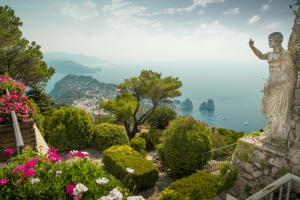
The Blue Grotto (Grotta Azzurra) is one of the most famous and iconic natural attractions on the island of Capri, Italy. This stunning sea cave is renowned for its mesmerizing azure blue waters and ethereal, glowing light that creates a magical and surreal underwater world. The Blue Grotto is a must-visit destination for tourists and travelers exploring the beautiful island of Capri and the Amalfi Coast.
Located on the northwestern coast of Capri, the Blue Grotto is accessible only by sea, making it a popular stop for boat tours and excursions departing from the Marina Grande or Marina Piccola harbors. Visitors can reach the cave by boat and then transfer to small rowboats, which are guided by experienced boatmen through a narrow and low entrance into the grotto.
The unique and mesmerizing blue color of the water inside the Blue Grotto is created by the sunlight filtering through an underwater cavity and reflecting off the limestone seabed, illuminating the cave with a radiant blue light. The water inside the grotto is incredibly clear and calm, allowing visitors to see the seabed and the fascinating rock formations below the surface.
Inside the Blue Grotto, visitors can admire the stunning natural beauty of the cave's interior, with its high vaulted ceilings, shimmering blue waters, and intricate stalactites and stalagmites. The boatmen often serenade visitors with traditional Neapolitan songs, adding to the enchanting and romantic atmosphere of the grotto.
Due to its popularity and limited size, the Blue Grotto can get quite crowded during the peak tourist season, especially in the summer months. To avoid long waits and overcrowding, it's recommended to visit the grotto early in the morning or late in the afternoon when the sunlight creates the most vivid and beautiful blue reflections on the water.
While visiting the Blue Grotto, it's important to respect the natural environment and adhere to the rules and regulations set by the local authorities to protect this fragile and unique ecosystem. Swimming and diving are not permitted inside the grotto to preserve the water quality and the delicate limestone formations.
Explore Near Blue Grotto Capri
Discover 5 attractions, 5 cities, and 2 airports within 75km. Perfect for planning day trips, finding connecting flights, or discovering new destinations to explore during your visit.
Nearby Attractions & Places to Visit
5 destinations within 2.4km - 24.8km from your location





Nearby Cities Worth Exploring
5 destinations within 28.4km - 30.4km from your location
Airports Near Blue Grotto Capri
2 destinations within 36.8km - 59.9km from your location
Cross-Border Adventures Near Blue Grotto Capri
Discover cross-border adventures near Blue Grotto Capri. Explore neighboring countries with similar attractions and extend your travel experience across borders.





